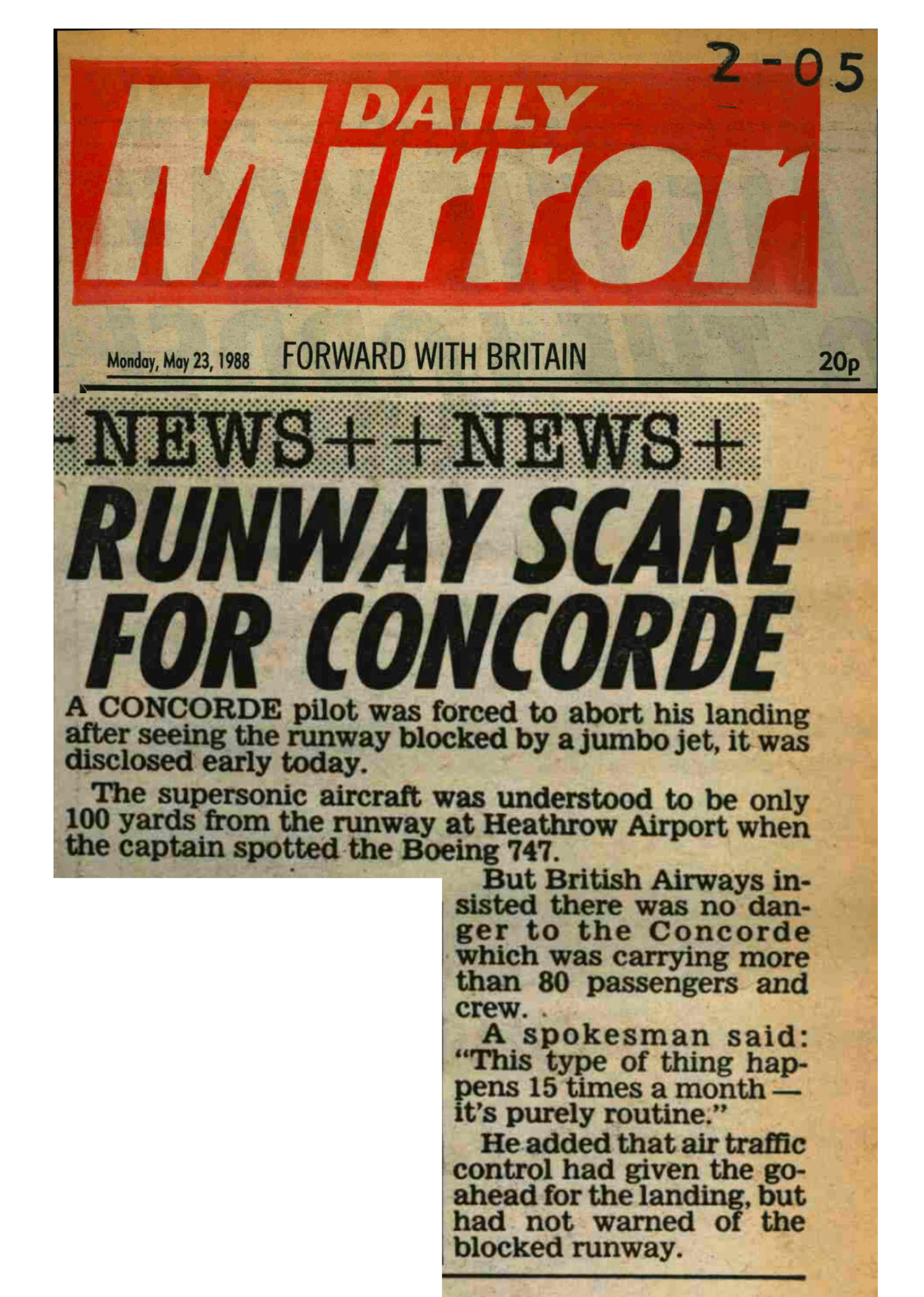A Concorde Close Call - Not!
It’s the daily New York/London late show, a routine dark arrival at London in time for a pint at the Peggy Bedford. Clear weather, everything as usual, and the airfield quiet – just ourselves following a BA 747 to the runway. The controller anticipated a late landing clearance due to this aircraft in front.
At night the relationship between airliner and air traffic control changes because less can be seen in the dark, rather like low cloud or fog, but not as serious. Although the jumbo ahead was in sight the man in the tower could not clear us to land until it had cleared the runway, unlike ‘decide for yourself’ in daylight. We watched it land and trundle, and continued. Entitled to take its time before turning off, maybe more of it than usual, our situation started to look more critical as it passed the usual high speed turnoff abeam the central area. Perhaps it would turn off in time, perhaps not.
We continued at our 185mph landing speed. Experienced co-pilot Tony Heald was flying. ‘We can go from the flare, if you like’, I suggested, familiar with what is sometimes necessary while teaching Concorde beginners. At about 100 feet the controller - keen to encourage us to land rather than noisily power into the sky - said, hastily, ‘The-747’s-turning-off-you’re-cleared-to-land.’
He was not completely wrong. It was in the process of turning, but the 200-foot long machine’s floodlit tail, now swung out across the runway, had not even reached its centreline, and this aircraft moved with caution in the darkness of the airfield’s remote west. Tony decided that this encouragement to continue was not applicable, announced “Go-around”, and opened the throttles.
The Concorde has the simplest of Go-Around modes: the pilot’s throttle-hand thumb. This hand is routinely in place during an approach, monitoring autothrottle activity. The pitch and vertical flightpath influences sent to the brain are algorithmed by this complex organ, which simultaneously coordinates instructions to the other hand on the joystick. A child uses the same cerebral function when mastering chopsticks on the piano. It doesn’t take long.
A simple press of the thumb cancels autothrottle, releasing total engine control to the pilot’s engine hand. The additional thrust required to reach full power for our old-school but beefed up V-bomber Olympus engines is available instantly. Even while flying downhill to land, the Concorde points skywards, and nothing else is needed to change a Concorde approach into an impressive climb. We roared briefly into the Heathrow night sky. What could be simpler?
Immediately, the steward from the front galley burst into the cockpit – shaking with shock. “What’s happening!?”
“Jumbo on the runway, be down in a few minutes.”
He was not reassured. “But this is not normal, what’s gone wrong?”
“Nothing, one of those things.”
After the usual explanation to the cabin all seemed quiet. We completed a quick circuit and landed undisturbed by more jumbos, went home, and I thought no more about it.
Next morning I was phoned by Alan Harkness, our training manager. “Did you do a go-around at London last night?” One associates this civil transport term with bad weather, and I had to think about what he meant, at first. But how did he know about such a triviality? Is it possible that the spy-in-the-sky flight recorder playback had flagged up this ‘event’ already?
“Yes” I said. “Jumbo was slow to clear.”
“You’re supposed to do an incident report – going around below decision height.”
He was officially correct, although this decision height business – ‘decide’, then a choice of land or go-around statements etc – is usually associated with cloud or fog (blind flying). This circumstance was nothing like that. Then he asked whether I had seen today’s Daily Mail. I hadn’t. “Go and get a copy, You’re on the front page.”
I eagerly did so, even though this required a brief country lanes motor to the village shop. I don’t think the heroic crew were named, so I was on the front page in spirit only. The only person mentioned was alarmed passenger Dave Stewart of Eurythmics, currently toing and froing between London and New York, and possibly the London source of the late night hold-the-front-page big writing. But it was a typical piece of bigging up the trivial for a sensational story. The item began:
Landing Concorde misses Jumbo by Inches
“While landing at London’s Heathrow airport last night a Concorde was just inches from the ground when the pilots spotted a jumbo jet on the runway and narrowly missed it by taking off again.”
(By Jove, Carruthers, isn’t that a jumbo on the runway? Good Lord, you’re right, skipper! Better keep your eyes peeled in case there’s another of the blighters out there).
Passengers described the terrifying experience …’
I don’t have a copy of the related edition, but you get the idea. If readers wish to research the story, first reports of the spectacular event appeared on May 23rd 1988. There are no pictures, and the Daily Mirror was more restrained:
The story spread via the superfast world news gravevine. Sandwell Evening Mail West Bromwich had this to say.
But closer to home is this report from the Staines and Ashford News of May 26th. It’s wonderful what 3 days mental struggle over the writer’s desk can do. I sense the original Topgun experience here - ‘Tom gets to fly the Concorde, Yee-Hah!’ Love it.
Later that morning I met author, journalist and pilot David Moreau (More Wrestling than Dancing) at the West London Aero club. When I explained the reality of this Daily Mail shocker, he wrote a substantial Evening Standard article that afternoon, critical of this eye-catching nonsense for the people. As an acquaintance I might have got a mention here as informant and the sage voice of reason. I think I did. Fame at last.


